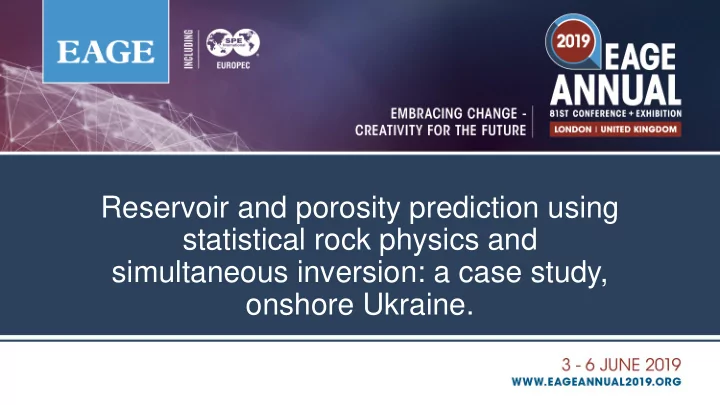

Reservoir and porosity prediction using statistical rock physics and simultaneous inversion: a case study, onshore Ukraine.
1394 Timothy Tylor-Jones, DownUnder Geosolutions Ievgenii Solodkyi, DTEK Oil and Gas Ivan Gafych, DTEK Oil and Gas Chris Rudling, RPS Energy
Contents 1. Introduction • Study area background • Subsurface challenges 2. QI Methodology • Project workflow • Seismic data processing • Depth-dependent rock physics 3. Inversion results • Prediction • Interpretation 4. Conclusions
Study Background • Basin : Dnieper-Donets (~99,000 km 2 ). • Source: Visean red bed mudstone and coals. • Reservoir : Lagoonal, fluvio-deltaic sheet sands with some shallow marine sands • Seal : Intra-sand shales. • Trap : Anticline with gently dipping flanks. • Field : The Semyrenky gas field, operated by DTEK. • Production : at 5,500 m, encountering very high pressures (3,475.6 psia) and temperatures (128º C).
Field Development Challenges Noisy and Identifying and Unpredictable Well discontinuous mapping sands on Performance seismic events seismic No Good production production Vsh Phie Vsh Phie Sand ? Sand ? Sand ? 45m 35m Sand ? Solution = Targeted seismic processing + bespoke rock physics model + seismic inversion
Contents 1. Introduction • Study area background • Subsurface challenges 2. QI Methodology • Project workflow • Seismic data processing • Depth-dependent rock physics 3. Inversion results • Prediction • Interpretation 4. Conclusions
Project QI Workflow SEISMIC SIMULTANEOUS INTERPRETATION REPROCESSING INVERSION Probabilistic Bayesian • Remove multiple INPUT OUTPUT Seismic angle stacks Classification Legacy Final seismic • Improve SNR seismic • Flatten gathers • Improve resolution PETROPHYSICS • Log editing Wavelets INPUT Lithology Probability OUTPUT • Synthetic log generation Raw well OUTPUT Rock property logs Final well logs volumes • Invasion correction • Vclay, Sw, φ ROCK PHYSICS • Statistical rock physics Porosity LFMs OUTPUT • Stochastic forward models IP Rock physics • Depth-dependent model Rho interpretation criteria Vp/Vs GEOLOGICAL PRIOR • Horizon interpretations
Seismic Re-processing DUG Re-Processing (PSDM in time) Legacy Processing (PSDM in time) Re-processed seismic shows • Reduced noise • Improved resolution • Better event continuity 12hz
Petrophysical Evaluation Vsh Sw Phie IP Vp/Vs The main reservoir is the V19 sandstone: • V17v A sheet sand present in all wells. • Varies in thickness (12 to 30 m) and in reservoir properties. V18 V19
Statistical Rock Physics: End-Member Picks & Trends GR, Cal Res Den, Neu Vp, Vs IP vs. Depth Vp/Vs vs. Depth V17v V18 V19 • Three types of sands and three types of claystones were identified. • A rock property to porosity relationship was established for the sands.
Stochastic Forward Modelling • End-member distributions any depth at any depth are stochastically sampled. • The realisations are summarized using probability density functions (PDFs). • PDF characteristics vary with depth.
Depth Dependent PDFs AI vs. Vp/Vs at 4800 m TVDBML AI vs. Vp/Vs at 5500 m TVDBML Low Vp Shale Low Vp Shale Shale Shale Vp/Vs Vp/Vs High Vp Shale High Vp Shale Low Vp Low Vp Sandstone Sandstone High Vp Sandstone High Vp Sandstone Sandstone Sandstone AI AI • Good separation of sand from shale. • Fluid separation varies with sandstone type. • PDF characteristics change with depth.
Contents 1. Introduction • Study area background • Subsurface challenges 2. QI Methodology • Project workflow • Seismic data processing • Depth-dependent rock physics 3. Inversion results • Prediction • Interpretation 4. Conclusions
Lithology and Fluid Prediction – Control Wells Well 52 Well 67 Well 73 • Rock properties from simultaneous inversion were compared against depth-dependent PDFs. • A Bayesian classification scheme was used to derive lithology and fluid probability volumes. • Interpretations from inversion results agree with well log interpretations.
Lithology and Fluid Prediction – Blind Wells Well 43 (Blind well) Well 61 (Blind well) • Inversion results and interpretations also agree with wells that were blind to the project.
Interpretation: Seismic 67 34 7 18 11 V16 Thick Sand? Thick Sand? V17 AI + Sand? V17 V17 Sand? V19 Sand? Thick Sand? AI - • Mapping sands on seismic is ambiguous.
Interpretation: Most Likely Sands 67 34 7 18 11 V16 V17 V17 V17 V19 • Using inverted rock properties can help sand mapping between wells.
Interpretation: Most Likely Sands 67 43 34 61 7 18 11 V16 V17 V17 V17 V19 • Blind wells Post-inversion increase confidence in the sand prediction.
Interpretation: Porosity 67 43 34 61 7 18 11 V16 V17 Phi V17 V17 V19 • Different sands have different porosities which can affect production.
Interpretation: V19 sand Sand Type Classification Sand Porosity Prediction 43 7 18 11 67 23 11 67 43 7 18 23 = Porosity <6% = Porosity >9% • High Vp sands are seen on the periphery of the field with low porosities. • Well 11 and 18 have poor V19 production. • Wells drilled in the center of the field have good V19 production.
Conclusions In the Semyrenky gas field: • Seismic re-processing has reduced noise and improved event resolution and continuity. • Three types of sands have been mapped using simultaneous inversion results. • Interpretations are validated by wells that were blind to the study. • Production is controlled by sand type distributions and porosity.
Acknowledgements / Thank You / Questions • DUG QI, Petrophysics and Processing Teams Sagar Ronghe Owen King Dan Franks Anne Locke • All thanks to DTEK for allowing DUG to present this case study and RPS for their ongoing technical support.
Recommend
More recommend